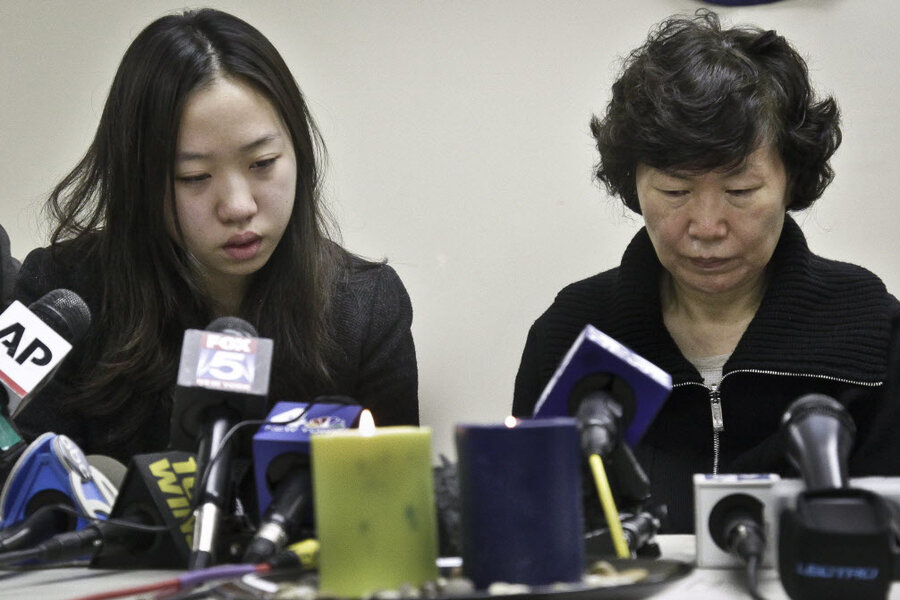'What's done is done,' says NY subway victim's daughter
Loading...
| New York
The daughter of a man pushed in front of a subway train and photographed a split-second before his death said Wednesday after a suspect was arrested that it "would have been great" if someone had helped her father up but "what's done is done."
A freelance photographer for the New York Post was waiting for a train Monday afternoon when he said he saw a man approach 58-year-old Ki-Suck Han at the Times Square station, get into an altercation with him and push him into the train's path.
Naeem Davis, 30, was taken into custody for questioning Tuesday after security video showed a man fitting the suspect's description working with street vendors near Rockefeller Center. Police said Davis made statements implicating himself in Han's death.
Davis, who police said was homeless, was arrested on a second-degree murder charge. He was in custody, and it wasn't immediately clear if he had a lawyer. He has several prior arrests in New York and Pennsylvania on mostly minor charges including drug possession.
Han's only child, 20-year-old Ashley, said at a news conference Wednesday that her father was always willing to help someone. But when asked about why no one helped him up, she said: "What's done is done."
"The thought of someone helping him up in a matter of seconds would have been great," she said.
Ashley stood with her mother, Serim Han, inside their Presbyterian church in Queens. The family came to the U.S. from Korea about 25 years ago. They said Han was unemployed and had been looking for work. Their pastor said the family was so upset by a front-page photo of Han in the Post that they had to stay with him for comfort.
"I just wish I had one last chance to tell my dad how much I love him," Ashley Han said.
The Post photo in Tuesday's edition showed Ki-Suck Han with his head turned toward the train, his arms reaching up but unable to climb off the tracks in time.
The photographer, R. Umar Abbasi, told NBC's "Today" show Wednesday that he was trying to alert the motorman to what was going on by flashing his camera.
He said he was shocked that people nearer to the victim didn't try to help in the 22 seconds before the train struck.
"It took me a second to figure out what was happening ... I saw the lights in the distance. My mind was to alert the train," Abbasi said.
"The people who were standing close to him ... they could have moved and grabbed him and pulled him up. No one made an effort," he added.
In a written account Abbasi gave the Post, he said a crowd took videos and snapped photos on their cellphones after Han was pulled, limp, onto the platform. He said he shoved them back as a doctor and another man tried to resuscitate the victim, but Han died in front of them.
Mayor Michael Bloomberg said Han, "if I understand it, tried to break up a fight or something and paid for it with his life."
The suspect's last known address was in a working-class neighborhood in Queens. The only neighbor who even vaguely remembered Davis was Charles Dawes, 80, who stays with his son two doors down.
Davis "came and went, came and went, and he always looked serious," Dawes said. "But I haven't seen him for three or four months."
Subway pushes are feared but fairly unusual. Among the more high-profile cases was the January 1999 death of Kendra Webdale, who was shoved to her death by a former mental patient.
Straphangers on Wednesday said that they were shocked by Han's death but that it's always a silent fear for many of the more than 5.2 million commuters who ride the subway on an average weekday.
"Stuff like that you don't really think about every day. You know it could happen. So when it does happen it's scary but then what it all comes down to is you have to protect yourself," said Aliyah Syphrett, 23, who sat on a bench as she waited at Pennsylvania Station in Manhattan.
Diana Henry, 79, a Long Island resident, was waiting for a train at 34th Street. She stood as far from the platform as possible — about a dozen feet back, leaning against the wall.
"I'm always careful, but I'm even more careful after what happened," she said. "I stand back because there are so many crazies in this city that you never know."
Associated Press writers Verena Dobnik, Karen Matthews and Tom Hays contributed to this story.







